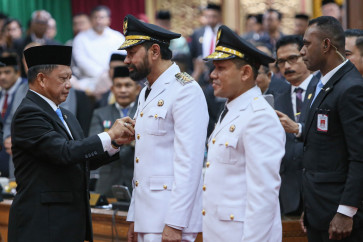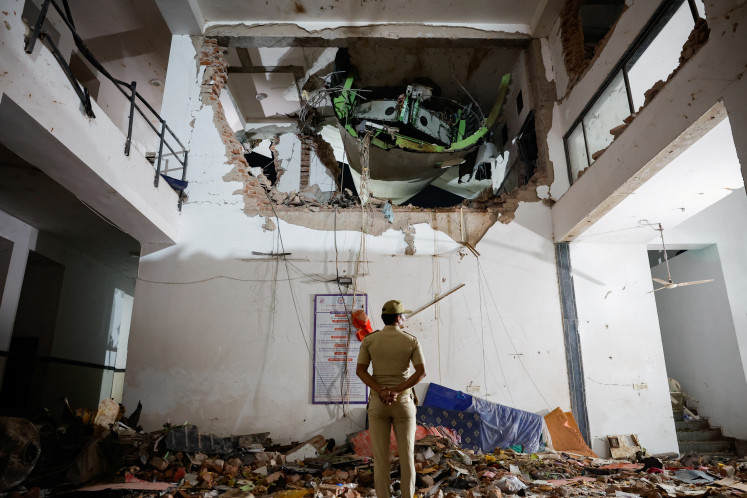In 2019, has ASEAN redefined the Indo-Pacific?
After accompanying President Joko “Jokowi” Widodo for an ASEAN Summit plenary meeting one Saturday night in June this year, Foreign Minister Retno LP Marsudi immediately called for a press briefing announcing the adoption of a five-page document that would come to be known as the ASEAN Outlook on the Indo-Pacific (AOIP)
Change text size
Gift Premium Articles
to Anyone

A
fter accompanying President Joko “Jokowi” Widodo for an ASEAN Summit plenary meeting one Saturday night in June this year, Foreign Minister Retno LP Marsudi immediately called for a press briefing announcing the adoption of a five-page document that would come to be known as the ASEAN Outlook on the Indo-Pacific (AOIP).
The document, which was already in the works for almost a year at that point, outlined the group’s shared stance in a region that straddled the Indian and Pacific oceans — the result of a shifting geopolitical landscape ushered in by the rise of China and a preoccupied United States.
“From now on, when we discuss the Indo-Pacific, ASEAN as a whole has a perspective on what elements it should entail, what principles are used and what cooperation we want,” Retno said in Bangkok at the time.
The adoption of the outlook document, while still sparse in its textual dimensions, was arguably one of Indonesia’s biggest diplomatic achievements this year, especially with the amount of skepticism and the rumors of pushback from fellow ASEAN members that circulated in the weeks leading up to the Bangkok summit.
President Jokowi was named The Straits Times’ “Asian of the Year” for his role in introducing the AOIP cooperation concept, the Singapore-based newspapers’ editors said.
Many countries have already devised policy papers about this expanded Asia-Pacific region in the past few years, all of them competing to pen a vision of a regional order that best suits their respective national interests.
The idea of an Indo-Pacific vision is itself not new, as foreign policy practitioners and experts around the world have made use of the term in one way or another. But it was US President Donald Trump who unwittingly brought it into the mainstream during his Asian tour in 2017, when he decided to run with what insiders say was a remnant of Obama-era foreign policy.
Since then, Japan, India and Australia, as well as other countries located in the region, have developed their own Indo-Pacific concepts.
Experts have noted that these four countries also formed the Quadrilateral Security Dialogue — also known as the Quad — a forum revived on the margins of the ASEAN Summit in 2017 as a response to China’s rapid economic rise and its growing ambitions in the South China Sea. Crucially, these countries have thrown their support behind the ASEAN outlook document.
The Indo-Pacific strategy has also set up expectations on how countries to some extent should behave in the South China Sea — a highly disputed, resource-rich body of water that is also one of the world’s busiest maritime trade routes.
China has made sweeping claims over the waters, and even though they were invalidated by a 2016 international arbitration ruling, Beijing continues to militarize the area and engage in hostile standoffs with other claimants, fraying nerves in the region. Taiwan, Vietnam, Malaysia, Brunei and the Philippines have overlapping claims with China.
Without a shared perspective on what constitutes a new Indo-Pacific order, there was not much that countries could do in forging security and economic cooperation for mutual benefit.
“Southeast Asia lies in the center of these dynamic regions and is a very important conduit and portal to the same. Therefore, it is in the interest of ASEAN to lead the shaping of their economic and security architecture and ensure that such dynamics will continue to bring about peace, security, stability and prosperity for the peoples in Southeast Asia, as well as in the wider Asia-Pacific and Indian Ocean regions or the Indo-Pacific,” the outlook document states.
Being situated in the eye of the storm and bordering both the Indian and Pacific oceans with the South China Sea at its doorstep, Indonesia wanted ASEAN to have a say in shaping the regional order.
Retno did not waste any opportunity to promote “an open, transparent and inclusive regional architecture based on international law”, which, unlike other countries, did not shy away from embracing China. For her notable resolve, Chinese Foreign Minister Wang Yi reportedly gave her the nickname “Miss Indo-Pacific”.
The concept rests on ASEAN centrality — the idea that because ASEAN countries do not pose a threat to any country, it is able to convene all the relevant countries in one forum. Its flagship mechanisms, the East Asia Summit and ASEAN Regional Forum, regularly gather regional powers every year to talk about the newest way to foster security and economic cooperation.
“Using the chessboard analogy, the AOIP keeps ASEAN central. But the 10 ASEAN member states have to be aware that centrality has to be [earned]; it's not something that’s a god-given right [and] it doesn’t happen automatically,” said Kok Li Peng, Singapore’s permanent representative to ASEAN.
“But at least with this AOIP we have kept ourselves relevant and we can choose which chess piece we want to be. We can talk about the design of the chessboard and we can talk about the rules of the game,” the envoy said in a recent discussion.
While Indonesia focused on exploring cooperation in the maritime sector and on connectivity, sustainable development goals and economic cooperation — all geared to encourage collaboration based on commonalities instead of differences — observers looked to the conclusion of the Regional Comprehensive Economic Partnership (RCEP), which intends to form a trade bloc comprising ASEAN and its six dialogue partners, including China and India, as the first stress test.
The deal did not satisfy India, which decided to pull out last month over fears that its vast consumer market would be flooded by goods from other nations.
Another flashpoint for ASEAN centrality is the negotiation of a Code of Conduct in the South China Sea with China. While ASEAN and China completed a first reading of the draft codex ahead of schedule this year, tensions between the claimants continue to flare. Chinese and Vietnamese vessels were repeatedly involved in clashes near an oil block concession within Vietnam’s exclusive economic zone between June and late October.
Manila-based political analyst Richard Heydarian said while there were areas where ASEAN took on a central role, the South China Sea dispute was not one of them.
“When certain people, especially the [US] Trump administration and some of the Quad members, talk about the Indo-Pacific, it's a euphemistic way of saying, ‘ASEAN you did not hold China, let us hold the line right now.’ Of course they are not saying that in public but they are much more skeptical toward ASEAN. It's not enough to just say we are central, we have to prove that while at the same time reminding everyone that we are already central in certain areas like the RCEP negotiation,” he said.









